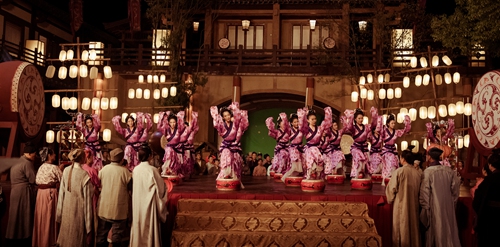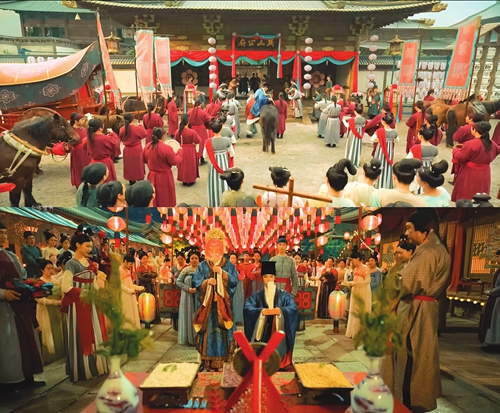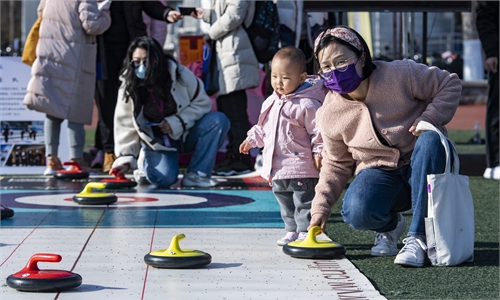ARTS / CULTURE & LEISURE
TV shows turn to traditional culture to satisfy young audiences
Obsessed with the ancients

A scene from Dancing Through the Millennium Photo: Courtesy of Bilibili

A scene from Luoyang Photo: Courtesy of iQIYI
Performers wearing traditional gowns, eating traditional dishes and speaking in archaic Chinese… more and more period dramas are focusing on the exquisite details of traditional Chinese culture in order to satisfy audiences' desire to experience ancient China and promote traditional Chinese culture.
Luoyang, located in Central China's Henan Province, is a city with a history that can be traced back to more than 5,000 years ago. It was the capital city of 13 Chinese dynasties, making it a central figure in Chinese culture. Now the historic city is being revived on screen in the TV series Luoyang.
Airing on streaming platform iQIYI since December 1, the show has become one of the most attention-grabbing TV dramas of 2021 in China.
The 39-episode period drama telling the story of three people from different classes uniting together to protect the historic city has topped the trending chart for dramas in the Chinese mainland on Maoyan, a major database for films and TV series.
At the same time, a traditional dance TV program has also gone viral on China's site Bilibili. Dancing Through the Millennium has brought the essence of China's 5,000-year history to life in front of audiences through the art of dance.
"Young Chinese are obviously obsessed with traditional Chinese culture and they want to use it as a pivot to gain a foothold in global pop culture," Jiang Xiaowei, director of Dancing Through the Millennium, told the Global Times, explaining why such TV shows focused on history have won such applause.
In 2020, there were 136 million traditional culture lovers active on Bilibili, a popular cultural gathering place for young people, according to data from the platform.
Reintroducing traditional culture
In Luoyang, Gao Bingzhu (Chinese actor Huang Xuan), a young man low on the totem pole of society, is searching for the murderer who killed his friends five years ago when he becomes a suspect in a new case.
As Gao tries to prove his innocence by finding the real criminal, he meets Baili Hongyi (Wang Yibo) and Wu Siyue (Song Qian), who are from the noble class. The three unite together for different reasons to accomplish the same goal - arrest the rebels, who are trying to overthrow the emperor, and protect Luoyang.
As the three leads track down and chase after criminals and rebels, the scenic sights of the capital are rolled out for audiences at the same time. The scriptwriters Qing Mei and Wu Cong told the Global Times that the chase and fight scenes naturally take audiences on a tour of the ancient Luoyang the production team has restored on screen.
"I do not like using special effects," Xie said.
"Most of the buildings, streets and rooms of the lead roles shown on screen were really built before the drama began filming."
The props on display have stunned audiences since the series' made its debut.
Gao's bed is a coffin to show the depression caused by deep hatred his character feels, and Baili's room is surrounded by a small stream as this shows her completely unrestrained personality.
By presenting a string of stories from the Yuan Dynasty (1279-1368), from The Orphan of Zhao, a revenge play often called the Chinese Hamlet, to the craftsmanship behind Tang Dynasty (618-907) three-color glazed pottery, Dancing Through the Millennium has been "trying to extract all kinds of intriguing stories and the spiritual core of a classical culture that has been handed down for thousands of years in China," Jiang said.
Myths and legends are also source of inspiration for the show. The solo dance "Fire" depicts the story of a little girl who was afraid of fire the first time she sees it, but then takes on the mission of protecting fire for the sake of all human beings and finally merges and becomes one with it.
"This dance is taken from the worship of fire by humans in ancient times," said Jiang.
True to history
The production crews for the two shows have worked hard to ensure what is presented on screen is as authentic as possible.
The Luoyang Wenbao Group, mainly responsible for protecting the ruin sites in Luoyang and constructing cultural parks, told the Global Times that they introduced the architecture in the ancient capital to the production team of Luoyang and organized exchanges and discussions between experts in the history of the city.
Meanwhile, the director of Dancing Through the Millennium said that they pored over massive amounts of Chinese literatures and documents to find descriptions of these works and dances because none knew how ancient people danced and dressed.
At the beginning, the team was not that certain how such high-level art would be received by the mass TV audience.
"We were worried because people who are interested in this kind of thing usually buy tickets to the theater to appreciate it. We were not sure that the show would be successful or not," said Jiang.
"But still these traditional dances are not supposed to be hidden in theaters forever. As long as we do it well, the audience will also pay to see them on TV," Jiang noted.




